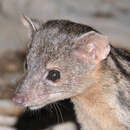Broad-striped Malagasy mongoose or vontsira fotsy (Galidictis fasciata)
provided by EOL authors
The broad-striped Malagasy mongoose is a mongoose-like member of the subfamily Galidiinae of the family Eupleridae, which was formerly included in the mongoose family (Herpestidae) (9). The specific name 'fasciata' means 'banded' in Latin; the animal was named by Gmelin in 1788 (8). The mongoose has a nimble, low to the ground body with short legs and a long bushy tail. The heads is long, slender and dorso-ventrally flattened with a pointed rostrum. The pale brownish, grey-beige or greyish fur extends to the under-belly and has @ 5 broad, longitudinal dark brown or black stripes on the back and sides: the dark stripes are broader than the creamy-beige spaces separating them and continue from the nape dorsally to about one third the length of the tail (3,6,9,10). The top of the head is darker than the cheeks, chin and throat. The tail is creamy white. The small ears are covered with short, fine fur. It is 30-34 cm long with a 24-30 cm tail and weighs 380-800 g. The male is larger than the female. The other species of Galidictis, G. grandidieri, has dark stripes narrower than the lighter spaces; the outermost portion of the ear lacks fur. (6,9,10).
This species is endemic to eastern tropical humid forests of Madagascar (8,9,13). It is widely distributed from the lowlands (@ 400 m to @ 700 m above sea level (5) with one record in montane forests at 1,500 m (6,7). It seems to be limited to forests on lateritic soils, but occasionally lives in degraded forest (12). It has been reported from the Mananara-Nord region in the north to the Réserve Naturelle Intégrale (RNI) d'Andohahela in the south.There is no firm evidence that it lives further north than the Marojejy Massif, which is south of the Masoala Peninsula in the extreme northeast of the island (3,4,6,7,10)
It is largely terrestrial and is most active at dawn, dusk and at night (9,13). It may climb in trees and on large, fallen logs (6,7). It lives in pairs (9). It probably uses a combination of tactile, visual, chemical and accoustic cues to deal with its environment and other members of the species (1). It feeds mainly on small rodents (13), but may also eat small lemurs, reptiles, amphibians and other vertebrates (9), possibly at or above its body weight, as well as insects and other invertebrates (1,3,6,9-11).
The animal probably breeds annually (1). A female captured in November did not show reproductive characteristics; males captured in October and late November did have scrotal testes volume of 1884 mm ((3,6,10). Garbutt (3) says the species is probably pair-bonded and hence monogamous; the sociality may extend to a mate and offspring. The lack of highly developed sexual dimorphism supports this possible mating system (3,6,10). The mother gives birth to one young in summer (3,6,9,10). She has two mammae and probably provides the young with shelter, milk and protection at least until the time of weaning or perhaps until it is sexually mature, at around 2 years (1,3,6,10).
In 2008, the animal's Red List category was assessed as 'Near Threatened,' as it is widely dispersed, but at low densities (5,8). Over the previous 10 years, the population reduction was estimated at 20-25%, due to human advancement into the forests, habitat loss and the effects of feral carnivores, such as dogs and cats and introduced Indian civets, which compete for food (2,8). In 1996 and 2000, the species was assessed as 'Vulnerable.' It has been recorded from a number of protected areas, including Marojejy, Masoala, Zahamena and Ranomafana National Parks.
There are two subspecies: G. f. fasciata has a bushier, bay or reddish-brown tail and 8-10 stripes; G. f. striata has a thinner, white tail and 5 stripes (9,13).

